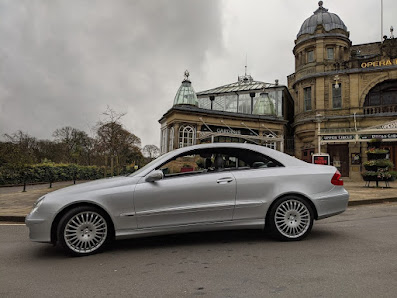W209 CLK: Does weight = luxury?
Having experienced the incredibly light feeling doors of a modern Mercedes-Benz C-Class, it's not a given that you'll have this experience with all luxury cars. I'm reminded of the slimy lawyer in the movie Jurassic Park, admonishing the young lad for messing about with night vision goggles;
"Is it heavy?"
"Yeah."
"Then put it back, it's expensive."
One argument might be that it's not a particularly luxurious experience, having to engage one's muscles and heave a heavy door open. But, it's that subtle underlying feeling of weight to the car that, rightly or wrongly, helps make you feel safe. The car feels planted on the road at higher speeds, and, in the unfortunate event of an accident you feel the build quality will help absorb the forces of the impact and keep you in one piece.
This is all the more desirable when you take into account the lack of a b-pillar in the CLK’s "Pillarless" design. With the windows down, you can peer through the large open space from one side of the car to the other, without being hindered by anything as garish as a middle pillar.
And as the unfortunate lawyer in Jurassic Park noted - the weight also helps evoke an underlying feeling of value. The more stuff something is made of, the more it's worth, right? Those dodgy speakers I bought from a man in a van - that turned out to be filled with concrete - aside, there's at least some merit to this line of thinking.
Even the key feels weighty. Of all the car keys I've used - including those from Audi and BMW, the trapezoidal shaped Mercedes-Benz key, flanked by smooth chrome, is the most pleasing to hold and use. They must have known they got that key right, as it continued to be supplied with new Mercedes-Benz vehicles for many years.
This feeling continues to the interior of the car, where the dashboard materials are not exactly soft-touch, but solid feeling and lack any of the 'scratchy' cheap plastic that is found in abundance in entry level vehicles. The ends of the doors are capped in chrome, and the metal kick plates announce Mercedes-Benz in that classic font they so love to use.
The leather and other materials used to produce the seats in 2000's era Mercedes' seem to be of the highest quality. When I first saw my car, I assumed the fantastic condition of the seats was down to the low mileage and the fact that their experience of 15 years of use was that of being infrequently sat on by a little old lady.
Perusing the Autotrader website confirmed that this is not the case - and nearly every CLK I've seen has seats that look almost new. Here's one with, I kid you not, 190,000 miles on the clock:
190,000 miles, and seats are almost as-new
It does make you wonder how easy it would be to spot a clocked CLK!
There is some debate about the general quality of Mercedes-Benz of the early 00's, with many suffering from rust and interior plastics that don't last, or go "sticky". From my experience at least, I think the designers of the CLK must have missed this cost-saving memo from the higher-ups. There's not really any evidence of penny-pinching that I can see.
Perhaps weight is a sign of inefficiency, of laziness of design and the use of old fashioned materials. But as far as my everyday experience is concerned, I'm glad that the CLK likes to eat its petrol with extra bacon, large fries and full sugar coke.
https://www.youtube.com/watch?v=rpg66n18XZc



Comments
Post a Comment